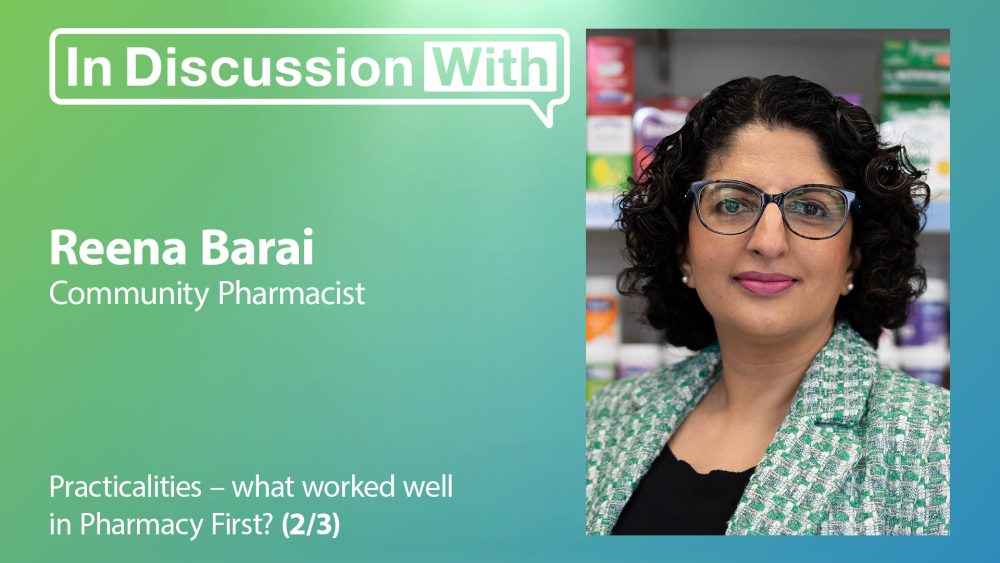Advertisment
Practicalities – what worked well in Pharmacy First?

The preparation for Pharmacy First Services was intense and so far, the systems put in place and the relationships nurtured have served the pharmacy well, community pharmacist Reena Barai, reflects. Preparations included making more extensive use of AccuRx software to enhance patient support.
Briefing GPs
“This was probably the first time in my career where the GP practices were asking to talk to me. Normally I’m the one with my hand up saying, ‘Please can I come and talk to you about something?’ and this is the first time they’ve actually said, ‘Reena can you come and talk to us about Pharmacy First?’. So, that’s been really positive, really, really, encouraging”, says Ms Barai. “I can see that general practice really want Pharmacy First to work”, she adds. If, as envisaged, the Pharmacy First Service frees up millions of GP appointments then GPs will be able to concentrate on the patients who really need their expertise. “The fact that we’ve got good, open dialogue and good relationships with our general practice colleagues is really helping to implement the service”, she says.
AccuRx
“When we were implementing this new service, we wanted to look for solutions that can make things a little bit easier for us and one of the IT softwares that we’ve been using for a long time is called AccuRx. What we were using it for was a messaging system to our patients to tell them that their prescriptions ready or to invite them for a blood pressure check or remind them of a covid vaccine appointment and what we realised is that actually there’s more to AccuRx than we first thought”, she explains. In fact, using AccuRx has enabled the pharmacy to do several things that underpin and enhance the services that are now being provided. For example, the team has been able to create templates for the safety-netting information and leaflets that have to be given to patients treated under one of the seven clinical pathways. This could be given during the consultation but sometimes it is helpful for patients to receive the information a few hours later when they have more time to digest it. In addition, “we’re able to use AccuRx, with the patient’s permission, to look at their health record – and that’s really important when we’re taking important decisions to supply prescription-only medicines via Patient Group Directions”, she says. Some PGDs have long lists of exclusion criteria that require detailed medical information and patients do not aways know the answers to these questions, so it is helpful to have access to the records in this way, she explains.
“The third thing that we’re really hoping to trial out is video consultations – that we’re able to do using AccuRx – and we feel this will be a game-changer because many pharmacies like mine only have one consultation room and actually, while we’re busy doing flu, Covid [vaccinations], hypertension, contraception and other local services plus Pharmacy First that one room is really being utilised quite a bit!”, says Ms Barai. If they were able to set up an area for video consultations that could be helpful for some patients. “We realise we can’t keep doing the things we’ve always done with the change that’s coming. We need to think differently and kind of bring [in] some digital tools to support us”, she says.
First experiences
“We saw 41 patients in the first month who were referred to us and 10 of those patients met the clinical pathway gateway”, says Ms Barai. For seven of these, treatment was supplied using the PGD but the remaining three were provided with support for self-care. This was important she says because she was able to explain that the illness was not so severe as to require antibiotic treatment but that the patient could return if symptoms worsened. Moreover, she points out, “the route to get back into pharmacy is really, really simple you just turn up or you ring. It’s not like you have to ring the next day at 8:30 in the morning try to get an appointment then they say ‘sorry we have to wait three days’ and so actually what Pharmacy First is going to create, I think, is an absolutely great way of supporting the self-care agenda.”
Ms Barai also believes that a reduction in overall prescribing of antibiotics might occur because of the Pharmacy First scheme. This could happen “because of the ease with which patients can come back if their symptoms deteriorate”. Currently this option rarely exists in general practice so patients may pressure prescribers for antibiotics or prescribers may err on the side of caution and prescribe antibiotics, for example, for young children.
About Reena Barai
Reena Barai started her career as a hospital pharmacist 25 years ago and then took over her family (community pharmacy) business 20 years ago. She works in the pharmacy six days a week, running the pharmacy. In addition, she is a co-founder and co-host of the Female Pharmacy Leaders Network and until recently she was the co-chair of an Integrated Neighbourhood Team. Previously she has worked in primary care and as a GP practice pharmacist and has been a CPP tutor. She has also served as a board member of the National Pharmacy Association and as a Committee Member of what was the Pharmaceutical Services Negotiating Committee (PSNC), now Community Pharmacy England (CPE).
Read and watch the full series on our website or on YouTube.
This episode of ‘In Discussion With’ is also on Spotify. Listen to the full podcast now.





